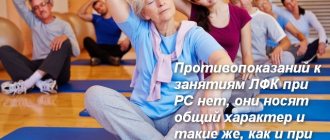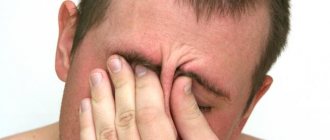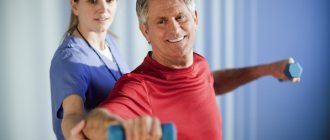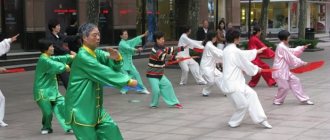Gymnastics for migraines[edit | edit code]
Main article:
Migraine (treatment)
Optimal types of load[edit | edit code]
- a ride on the bicycle
- walking
- run
- aerobics
- swimming
- Pilates
- yoga
- tai chi
Migraine
- a disorder of the brain that causes severe, throbbing, cyclical pain on one side of the head that can last several hours or days. Up to a third of migraine sufferers experience an “aura” before an attack begins: a wave of electrical activity across the surface of the brain that causes unusual sensations - tingling, bright lights, detachment from what is happening. Women experience migraines more often than men, often as a result of changes in estrogen levels.
It is known that a migraine attack can be caused by a variety of foods, medications, external irritants, and life circumstances. It is still not clear exactly how most of them trigger the physiological manifestations of migraine and why some of them work for some people and not for others. At the beginning of an attack, physical activity is useless: the pain is too strong and the overall health is too bad. In this case, it is best to lie down in a quiet, dark room and try to fall asleep. It may feel better if you place a cold, damp cloth or cold compress on your forehead, or tie it tightly.
However, migraine sufferers note that by staying physically fit, they can influence the frequency of attacks. Other ways to help avoid an attack include eating regularly to help maintain blood sugar levels, cutting down on caffeine and painkillers, avoiding exercise in hot weather, and getting regular, adequate sleep.
Sensory neurology[edit | edit code]
While for some, physical activity is an effective measure against migraines, for others, on the contrary, intense exercise will cause an attack. A study at the Headache Institute at St. Luke's-Roosevelt Hospital in New York found that migraine sufferers have a "sensitive nervous system." An attack can even be triggered by a change in daily routine, such as going to bed late or skipping lunch. Researchers believe that such people should create and adhere to a schedule not only for sleeping and eating, but also for regular exercise. Tips for avoiding exercise headaches (p. 62) also apply to migraines. Gradually entering a training regime will not create unnecessary stress on your nervous system.
Cycling reduces the frequency of migraines[edit | edit code]
The University of Gothenburg in Sweden has proven that the risk of increased seizures due to cycling is extremely low. A special training program was developed for migraine sufferers: 20 patients rode an exercise bike three times a week for 3 months.
As a result, their maximum oxygen consumption increased significantly. Attacks did not become more frequent during participation in the program, and in the last month, on the contrary, there was a significant decrease in the number of attacks, the number of days per month during which patients experienced pain, the intensity of pain and the amount of medications consumed.
Why train[edit | edit code]
Migraine sufferers often avoid physical activity for fear that it will trigger an attack. But without regular exercise, aerobic capacity declines and overall health deteriorates. Regular aerobic exercise (such as cycling) helps prevent migraines by increasing oxygen levels, reducing muscle tension and generally relaxing the body. Physical activity can help some patients even when they feel symptoms that indicate an attack is coming. Even if most of all you want to lie down at this time, try to move and stretch. Do some simple yoga or tai chi exercises, go for a slow swim, or, if this seems too difficult right now, just sit down, relax your neck and hang your head so that your chin almost touches your chest. Very slowly turn your head several times in one direction, then the same number of times in the other. Yoga exercises such as shoulder stand and fish pose, which relax the nervous system, will also be useful at this moment. A special breathing technique (pranayama), which emphasizes full diaphragmatic inhalation and exhalation, also helps to relax the mind and body.
How often?[edit | edit code]
- Start by walking, swimming or cycling for 10 minutes every day. Gradually increase the duration and intensity of training to 3 or more times a week for 30-60 minutes. At least once a week, perform a set of slow, meditative exercises: Pilates, yoga, tai chi are suitable.
Stretches to relieve headaches[edit | edit code]
Do these exercises twice a day, in the morning and before bed.
Perform slowly until a feeling of stretching appears, stay in this position for 5 seconds. Rest and repeat 3-10 times.
TILTING AND TURNING THE HEAD
Touch your chin to your chest; tilt your head back so that he looks up; turn your head to the side and try to touch one shoulder, then the other.
SHOULDER RAISES
Raise your shoulders up, then up and forward, then up and back.
STATIC EXERCISES FOR NECK MUSCLES
- Place your palm on your forehead and press your head against it. Hold this position. Don't move your head or hand.
- Repeat the exercise, placing your hand alternately on the right and left sides of your head.
HEAD RAISING
- Interlace your fingers and place them on the back of your neck at the base of your head.
- Pull your elbows forward and up to feel your head lift slightly.
Yoga asanas for migraines[edit | edit code]
Stress and muscle tension can cause a temporary narrowing of the blood vessels supplying blood to the brain. When they expand again, blood flow will increase dramatically, which can cause a migraine attack or just a severe headache. Yoga exercises such as shoulder stand and fish pose can help gently relieve muscle tension that causes vasoconstriction.
SHOULDER STAND
Lie on your back, bend your knees. Exhale, push your feet off the floor, and pull your knees toward your chest. Straightening your legs so that your toes point to the ceiling, place your open palms on your lower back. Support yourself with them while your torso and legs are pointing vertically upward. Maintain the position for as long as you feel comfortable.
FISH
Lie on your back. Inhale, lift your pelvis and place your hands, palms down, under your buttocks. Place your buttocks on your hands. Inhale, lift your upper torso and head off the floor, then rest your head on the back of your head on the floor, maintaining an arch in your back.
Head tilts
This exercise will help relieve tension in the cervical spine and relax the neck muscles - it is problems with this area that often cause severe headaches.
Photo: istockphoto.com
Performed from a standing or sitting position. Place your right hand on the top of your head and gently pull your head to the right. Stay in the extreme position for 15-20 seconds, then return to the starting position and then repeat on the other side. If there is no discomfort, you can do 5 bends to the right and left.
Forms of migraine
There are different forms of migraine: basilar migraine, retinal migraine, ophthalmoplegic migraine and so on, but the most important ones are with
and
without aura
. Migraine with aura occurs in less than 25% of cases. Migraine without aura is much more common. Aura is those symptoms that appear before or along with pain and are reversible.
There are different types of aura:
- visual - hallucinations and distortion of the perception of objects (most common),
- hemiparesthetic - numbness or showing of the limbs (skin sensitivity),
- hemiparetic - impaired motor functions (weakness, fatigue, drowsiness),
- dysphasic - impaired speech function (slurred/confused speech),
- mixed - a combination of several types.
Breath work
Nadi Shodhana helps cleanse the energy channels of the body. To do this, sit with your back straight and relax. Use your thumb to close your right nostril and begin to inhale slowly through your left. After this, exhale even more slowly. Repeat the same with the other nostril. Do the practice for 1 minute.
Sheetali is a cooling breath that allows you to feel relief from headaches.
Sit cross-legged. Stick your tongue out of your mouth a little and roll it into a “tube”. Begin to slowly inhale through it and exhale through your nose, closing your mouth. Repeat 3-4 times without haste. REFERENCE! Pranayama or breathing exercises in yoga provide relaxation, relieve tension, improve blood circulation and calm the nervous system. They help get rid of headaches caused by stress or an immobile lifestyle.
Prevention of migraines using osteopathic methods
Treatment of any disease is an expensive and time-consuming process, therefore, thanks to prevention, it is possible not only to prevent the development of pathology, but also to significantly reduce possible costs. In the case of migraine, everything is somewhat more complicated, since it is not always possible to determine its source.
There is no absolute cure for this disorder, since there are many reasons for the formation of brain dysfunctions. Therefore, in each specific case a personal approach is needed. Migraine prevention is the best way to prevent or minimize the occurrence of headaches. As a rule, attacks occur in people who sleep little or a lot, smoke, get nervous a lot and often, and abuse alcohol. By getting rid of such provoking factors, you can protect yourself from new migraine attacks.
The most effective, safe and universal means of preventing headaches will be osteopathic techniques. A significant advantage is that they focus not on eliminating the consequences, but on eliminating and preventing the root cause. After normal blood circulation is restored, you can quickly remove and prevent all migraine symptoms without pills.
Osteopathy considers headaches not as local, but as a malfunction that affects a number of body functions. A specialist is able to find the root cause of the pathology and, thanks to gentle non-invasive techniques, eliminate it. Cranial osteopathy makes it possible to restore proper circulation of cerebrospinal fluid and blood in the brain and stabilize the activity of the neuroendocrine and autonomic systems.
Using gentle techniques and hands, the osteopath normalizes blood flow in the brain and normalizes the mechanisms of narrowing and expansion of blood vessels, eliminating existing dysfunctions and deformations. In most cases, after a course of preventive osteopathic treatment, it is possible not only to get rid of migraine and prevent its recurrence, but also to improve metabolic processes and the functioning of the nervous system.
Also, an experienced osteopathic doctor will provide appropriate assistance for migraines, which are caused by stress and psychological factors. Osteopathic correction will eliminate pain and accompanying symptoms (nausea, weakness, dizziness, increased fatigue). A stable preventive effect is achieved by relaxing the body and eliminating muscle tension.
Yoga against migraines: how it works
An Indian study proved the effectiveness of the practice against migraine attacks in 2014.
In patients who did simple yoga 5 times a week, the number of attacks decreased threefold in just a month and a half. And it's easy to explain. Regular practice strengthens blood vessels, reduces stress and nervousness - the main triggers of migraines, and also normalizes hormone levels.
“Regular physical activity is recommended for migraines. Many studies have documented the positive effect of aerobic exercise in two ways: it reduces the intensity of attacks and their duration, says Ravikaran Kisan, a neuropsychologist at the University of SS Institute of Medical Sciences and Research Center and one of the authors of the study. “However, in some patients, intense physical activity provokes attacks, so they avoid training. In yoga, slow movements and static exercises do not give such a large load, but they relieve stress perfectly.”
Impact principle
Modern pharmacology offers a wide range of drugs that almost instantly eliminate pain and spasms. But this only masks the problem and prevents the organs from sending signals. Moreover, medications have side effects that lead to other problems.
A headache is a kind of signal that tells a person that the body is not working properly. Very often, spasms appear due to overstrain of the neck and back muscles. This is a common problem for modern people who spend most of the day sitting. Yogic exercises help relieve tension, normalize blood pressure and prevent headaches.
REFERENCE! Asanas and breathing practices eliminate the effects of stress, which also causes headaches. Yoga therapy focuses on gradual relaxation and slowing down. Complexes of various poses help improve the supply of oxygen to the brain and reduce the likelihood of migraines.
Camel Pose
This exercise relaxes the spine and shoulders well. If your headache is caused by tension in these areas, then it will certainly make you feel better.
Photo: istockphoto.com
Get on your knees, place them hip-width apart. Point the backs of your feet upward. Slowly arch your back without bending your hips - they should be at right angles to your shins. Place your palms on your heels and, pushing away from them, open your chest. In this case, the shoulders should be turned outward, and the shoulder blades turned inward. Stretch your neck and slowly lower your head. Stay in this position for 30 seconds, then raise your head, remove your hands from your heels and carefully straighten your back, returning to the starting position.
When performing the exercise, it is important to maintain calm breathing and try not to strain your stomach. If at the initial stage it is difficult for you to lower your hands to your heels, then place a cushion or a special block under your feet.










